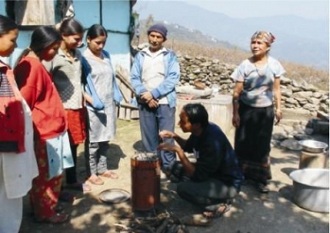Charles Rodes, senior fellow in aerosol exposure, advises the Aerosol Exposure and Biomass Cookstove Grand Challenge Programs at Research Triangle Institute (RTI). He has conducted health-based aerosol exposure research at RTI since 1992 (with 23 years previously at the U.S. Environmental Protection Agency) and works with epidemiologists and the medical community to optimize associative studies linking exposures with adverse outcomes.
One of his current efforts is the development of a micro-scale Personal Exposure Monitoring device (MicroPEM) which also predicts breathing rates that contributes to more meaningful environmental dose estimates. This technology will help scientists to better understand the relationship between environmental contaminants in the air from cookstoves and other sources on potential adverse health effects.
How did you first become interested in aerosol exposure and cookstove issues?
We have been addressing environmental and health hazard assessments associated with aerosols and black carbon from combustion sources for decades. Shifting to a cookstove focus in developing countries was an easy transition. I recommended that the RTI Fellow program support a cookstove research initiative as it’s first “grand challenge“. Subsequently, the New Yorker published an article on this topic that caught the attention of RTI’s then-president Victoria Haynes. With her support, we began investigating the social and technological aspects of the problem. In 2010, RTI formally launched an internal “Grand Challenge” research and development effort to begin a coordinated set of projects and activities to provide an integrated approach to solving the problems posed by biomass stoves. Through this Grand Challenge research, we have been able to advance a number of important contributions to the field.
How broad is RTI’s cookstove-related program?
I conducted our Grand Challenge effort initially from a gap analysis perspective – i.e. “what key elements to a solution set are we missing at RTI and where do we need to inject innovations that could help advance the field“. That proved right on target to supplement our skill set, but it was also clear that we needed to take the time to read papers and reports to learn from all the work that had gone before, both successes and shortfalls. One key point that seemed to jump out at me was the potential biases in the prior health studies from not using personal level exposure metrics, and applying surrogate measures for aersols because the existing monitors were too big, clumsy, and costly. The RTI MicroPEM certainly came to mind to help address that need. Another component we’re investigating is the relative toxicity of cookstove smoke and how that is likely to change as stoves are improved. There is a surprising paucity of stove-related toxicity data in the literature to support the most robust risk assessments.
But it also seemed clear that the interventional strengths of the “improved” stoves used in many studies were potentially marginal at best. We decided to see if the existing thermoelectrics program at RTI could build an improved stove that also minimally impacted the way people cooked with their indigenous stoves.
We also felt that the key to sustainable cookstove programs was likely to need the support of each country’s health ministry. Not only was there a stove-user educational component needed which they could facilitate, but typically these ministries have the ability to impact the way policies are made and followed that are crucial to making changes sustainable.
Has the new monitoring device been used in developing countries and does it have the potential to be useful in developing country IAP studies?
The device has a great potential to be deployed in IAP studies in developing countries but it’s ruggedness must be demonstrated along with it’s simplicity of application in-country. We are just beginning to collaborate with universities and others on activities in a number of countries, including: South Africa, DRC, Kenya, India, Guatemala, Ghana, and Sri Lanka. In the study in South Africa, exposure monitors with this embedded technology will be used over 48-hour periods to assess both exposures and potential doses to characterize impacts from indoor air pollution from cookstoves. Our goal is to provide an accurate and robust exposure metric at a very reasonable cost-per-data-point level. That would definitely facilitate a range of studies to evaluate relationships with health outcomes more accurately.
When did RTI develop the ThermoElectric Air Injection Insert and what are some of some of the advantages of this device?
RTI’s David Stokes is leading our work here. The thermoelectric-enhanced cookstove add-on (TECA) device is simply attached to an existing, or indigenous, cookstove to provide air injection to enhance combustion efficiency and reduce harmful emissions. That approach has almost no impact on the way food is cooked or the utensils used. As the fire reaches a nominal temperature, a blower, powered by a thermoelectric device, injects air into the combustion chamber to improve mixing of gases and minimize incomplete combustion. RTI’s thermoelectric air injection insert attaches to the side of an existing cookstove and has already been shown to reduce hazardous black carbon and particulate emissions by as much as 85% as compared to a traditional three-stone fire. The innovative RTI insert overcomes limitations of other models by pursuing a self-powered design that converts heat from the stove into electricity to self-power the fan. And, the prototype’s air injection system is added to existing stoves to significantly reduce emissions without replacing the user’s stove.
The device has the advantage of delivering a clean cookstove without facing as many barriers to adoption that have doomed many new cookstove programs. The proto-type is easily transported, distributed and requires no modifications to the existing stove. In our lab testing, the thermoelectric add-on device was able to produce excess power (700 mW), which holds the potential to power small electronics. The ability to recharge cell phones or power simple household lighting will excite consumers and bring rapid scale-up.
Can you briefly describe RTI’s findings on IAP issues in Sri Lanka and what are RTI’s future plans for IAP efforts in Sri Lanka?
RTI’s Myles Elledge is leading our work here. This research examines environmental health risk and biomass fuel stove use in Sri Lanka by working with the local health ministry. We have a couple of publications to date. Sri Lanka is a very interesting case study because of its:
- Heavy use of biomass for cooking, mostly in unvented homes. Over 78% of Sri Lankan households use biomass fuel as the main resource for cooking, even in urban areas.
- Large demographic that is at risk to IAP. Sri Lanka’s population demographic trends show both a large young population and a sizeable aging population, which is unusual in a lower income country. These factors suggest that IAP is a serious health risk for large segments of the population that are likely to be inside the home during biomass stove operation.
- Strong public health system ready to tackle IAP. To date, IAP is a neglected public health issue in Sri Lanka. Sri Lanka is widely recognized to have one of the strongest public health institutions in Asia, and given the country’s health metrics / status, it is now poised to turn attention to non-communicable and chronic disease
- Successful indigenous stove program. The Anagi stove, a clay improved stove, while modest in its improved nature, is an interesting case study of government-led innovation that in 8 to 10 years’ time progressed from trial, to NGO piloting, to widespread commercialization with over 300,000 stoves sold and in use.
In July 2012, RTI will again be working with the Sri Lanka National Institute of Health and a Sri Lanka non-government organization to conduct household exposure surveys using the MicroPEM. We will be evaluating IAP differences among three-stone fire and the commercialized Anagi stove in homes with and without ventilation.
WASHplus: Thank you for taking the time to respond to these questions. Additional information about Dr. Rodes’ work and RTI’s cookstove activities can be found on his RTI profile and the RTI website. This Q&A feature is also in a pdf format – Charles_Rodes-Q&A (pdf).




